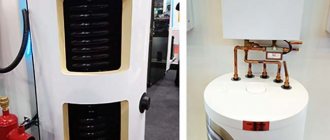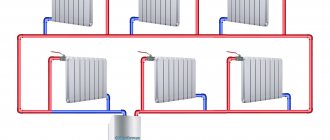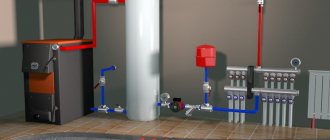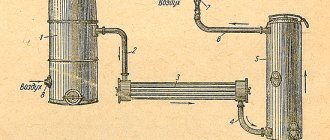Hydrogen is an almost ideal fuel for our planet. The only problem is that it is found on the planet only in combination with other substances. In its pure form, hydrogen on Earth is only 0.00005%. In this regard, the issue of designing hydrogen generators is very relevant. Do not forget that hydrogen is an endless source of energy, practically located under our feet.
Design and principle of operation of a hydrogen generator
How it works
A classic apparatus for producing hydrogen includes a tube of small diameter, often with a circular cross-section. Under it there are special cells with electrolyte. The aluminum particles themselves are located in the lower vessel. The electrolyte in this case is suitable only for the alkaline type. A reservoir is installed above the supply pump where condensate collects. Some models use 2 pumps. The temperature is controlled directly in the cells.
The generator receives gas from water. Its quality directly affects the amount of impurities in the finished product. So, if water with a high concentration of foreign ions enters the generator, it will first have to pass through a deionization filter.
Here's how the gas production process works:
- The distillate is split into oxygen (O) and hydrogen (H) through the process of electrolysis.
- O2 enters the feed tank and then escapes to the atmosphere as a byproduct.
- The H2 is supplied to the separator, separated from the water, which is then returned to the feed tank.
- The hydrogen is re-passed through a separation membrane, which extracts the remaining oxygen from it, and then enters the chromatography equipment.
Electrolysis method
As mentioned above, there are practically no inexhaustible energy sources in the world like hydrogen. We should not forget that 2/3 of the World Ocean consists of this element, and in the entire Universe, H2 coupled with helium occupies the largest volume. But to get pure hydrogen, you need to split water into particles, and this is not very easy to do.
Scientists, after many years of tricks, invented the electrolysis method. This method is based on placing two metal plates in water at a close distance from each other, which are connected to a high voltage source. Next, power is applied - and the high electrical potential actually breaks the water molecule into components, resulting in the release of 2 hydrogen atoms (HH) and 1 oxygen (O).
Hydrogen power station for households
In modern households, photovoltaic panels are becoming increasingly popular, helping homeowners save significantly by obtaining alternative energy from natural sources.
A team of scientists from Duke University led by Nico Hotz has improved traditional solar collectors by developing a fundamentally new product - a hydrogen-based hybrid power plant. The new installation looks just like regular solar panels and collects solar energy just like them. However, this is where the similarities end.
Sunlight is not accumulated in copper pipes coated with a layer of aluminum and aluminum oxide and filled with a small amount of water with nanoparticles, but heats a special mixture of water and biomethanol, which is located in sealed glass pipes laid on the roof. In batteries, two catalytic reactions occur that produce hydrogen. The resulting fuel can be used directly to generate electricity or sent to a storage tank.
The new development has several important advantages compared to the panel-battery circuit. First of all, hydrogen can be stored in fuel cells for a long time without significant losses. Also, the resulting fuel can be used not only in the home, but also outside it, for example, in a car. Another significant benefit is that the new fuel cells take up less space than battery-based systems.
The most important advantage of a hydrogen-based solar power plant is its high efficiency. According to scientists, the efficiency of the new system in summer is approximately 28%, in winter - about 18%. By comparison, for traditional photovoltaic panels these rates range from 5 to 15% in summer and 2-5% in winter.
Among the negative aspects of the invention is its high cost: the price of the minimum configuration starts from eight thousand dollars. In addition, to obtain energy from hydrogen, you need to have additional equipment. However, the developers promise to correct these shortcomings in the near future.
The author of the new technology, Niko Hotz, claims that scientists have already managed to obtain hydrogen in a presentation model of the device and generate energy from it. The next step for the developers will be to find an industrial investor, with whose funds it will be possible to launch production of the installation on a large scale.
Currently, scientists continue to improve the hydrogen power plant and promise that the new systems will absorb up to 95% of sunlight and will be able to heat water up to 200 degrees, which is 120 degrees more than the first generation of hydrogen plants. In addition, new catalysts are being developed that will increase the volume of hydrogen produced.
Subscribe to our Telegram channelExclusive posts every week
Hydrogen Generator Application Area
H2 is a modern energy carrier that is actively used in many industrial areas. Here are just a few:
- production of hydrogen chloride (HC)l;
- production of fuel for rocket launchers;
- ammonia production;
- metal processing and cutting;
- development of fertilizers for summer cottages;
- synthesis of nitric acid;
- creation of methyl alcohol;
- food industry;
- production of hydrochloric acid;
- creation of "warm floor" systems.
In addition, HHO has become very useful in everyday life, although with reservations. First of all, it is used for autonomous heating systems. In addition, Brown's gas is added to gasoline in an attempt to trick the engine and save on fuel.
Advantages of hydrogen heating
• no problem of fuel shortage, you mostly need ordinary water;
• economical consumption of electricity;
• during boiler operation there are no emissions of harmful carbon monoxide, only water vapor is released into the atmosphere;
• high efficiency;
• simple maintenance;
• saving money on heating the room.
When choosing and installing a hydrogen heating system, it is worth considering possible risks and disadvantages:
• when making a hydrogen system yourself, there is a high probability of leakage of the working mixture and explosion of the boiler due to a leak in the seal or an uncontrolled increase in pressure;
What is needed to make a fuel cell at home
Creating a hydrogen unit at home is not an easy task. You need to arm yourself not only with a number of tools, but also with relevant knowledge and diagrams.
Hydrogen generator design: diagrams and drawings
The device consists of a reactor with installed electrodes, a PWM generator for power, a water seal, wires and hoses connecting the structure. Today, several electrolyzer designs are known, where plates or tubes are used as electrodes.
Dry electrolysis devices are also popular. Unlike the classic version, in this unit the plates are not placed in a container with liquid, but the water itself is directed into the gap between the flat electrodes.
Selection of materials for the construction of a hydrogen generator
To make a generator at home, you do not need any special or unusual tools. Here's what you need to prepare:
- hacksaw for working with metal products;
- drill and drill bits for it;
- set of wrenches;
- flat and slotted screwdrivers;
- angle grinder (“grinder”) with a circle for cutting metal;
- multimeter and flow meter;
- ruler;
- marker.
Is it possible to create a hydrogen generator yourself?
It’s better not to take risks, because such a process is associated not only with the need to know the intricacies of technology and chemistry, but also requires proper compliance with safety rules. But installing the equipment yourself is possible. To do this, it is enough to follow the instructions and avoid amateur activities.
Heating of any home should ensure not only comfortable human living, but also the ecological cleanliness of the environment. This is achieved due to the fact that after the combustion of hydrogen no harmful compounds are formed.
In Western countries, heating using hydrogen generators has gained widespread acceptance and economic justification. If a similar method takes root in Russia, it will significantly increase heating efficiency with minimal resource costs.
DIY hydrogen generator: instructions
The process starts with the creation of a hydrogen production cell. In terms of dimensions, it should be slightly less than the internal parameters of the length and width of the generator housing. In height it is 2/3 of the height of the main building. The cell is made of PCB or plexiglass (wall thickness 5-7 mm). To do this, 5 plates are cut to size, from which a rectangle is glued, and its lower part is not covered with anything.
Using a grinder, electrode plates are cut out of a stainless steel sheet. They should be 10 - 20 mm smaller in size than the side walls.
IMPORTANT ! To obtain a sufficient amount of HHO, stainless steel should be sanded on both sides.
It is necessary to drill 2 holes in each plate: to supply water into the space between the electrodes and to remove Brown's gas.
Hydrogen at home: is there any benefit?
Let us note right away: using a hydrogen generator to heat a house is unprofitable. You will spend more electricity releasing pure H2 than you will gain from burning it. So, 2 kW of electricity is consumed for 1 kW of heat, that is, there is no benefit. It is easier to install any of the electric boilers at home.
To replace 1 liter of gasoline for a car, you will need 4766 liters of pure hydrogen or 7150 liters of detonating gas, 1/3 of which is oxygen. So far, even the best minds in the world have not developed a unit capable of delivering such performance.
Panasonic brings hydrogen power generators to the European market
Panasonic, one of the largest manufacturers of home hydrogen generators in Japan, has released two new models specifically for European countries
Hydrogen power generators for home use, which convert gas into electricity and heat, appeared in Japan in 2009. At the end of last year, their market size in this country was about $1.7 billion.
Now Panasonic, one of the largest manufacturers of home hydrogen generators in Japan, is preparing to expand into the European market: the company has launched two new models specifically for European countries and has entered into a cooperation agreement with German heating component manufacturer Viessmann.
Hydrogen electric generators convert the energy produced by the electrochemical reaction between oxygen and hydrogen, which are used as fuel, into electricity. The reaction produces only water and does not emit carbon dioxide, which is considered the main cause of global warming, Panasonic explains on its website.
However, this type of energy production cannot be called absolutely clean, since carbon dioxide is produced at the stage of hydrogen release. Panasonic's home hydrogen generators use gas supplied to homes via municipal grids as fuel and then use steam reforming technology to separate hydrogen and carbon dioxide from it.
A standard home hydrogen generator will cost around €25,000 in Germany, but some federal states provide subsidies for the installation of generators of up to €12,500. After the launch of new models in Germany, the companies plan to expand into the markets of Switzerland, Austria and the UK.
The Japanese government is actively supporting the transition to hydrogen fuel: the authorities will spend about $400 million to subsidize hydrogen transport for the Summer Olympic Games, which will be held in Tokyo in 2021. In the home hydrogen generator space, the government has also set an ambitious target of 1.4 million installations by 2021.
Honda and GM have previously stated that hydrogen is the fuel of the future. The companies each invested $85 million to build a factory in Michigan to produce hydrogen fuel cells for cars. published
PS And remember, just by changing your consumption, we are changing the world together! © econet











